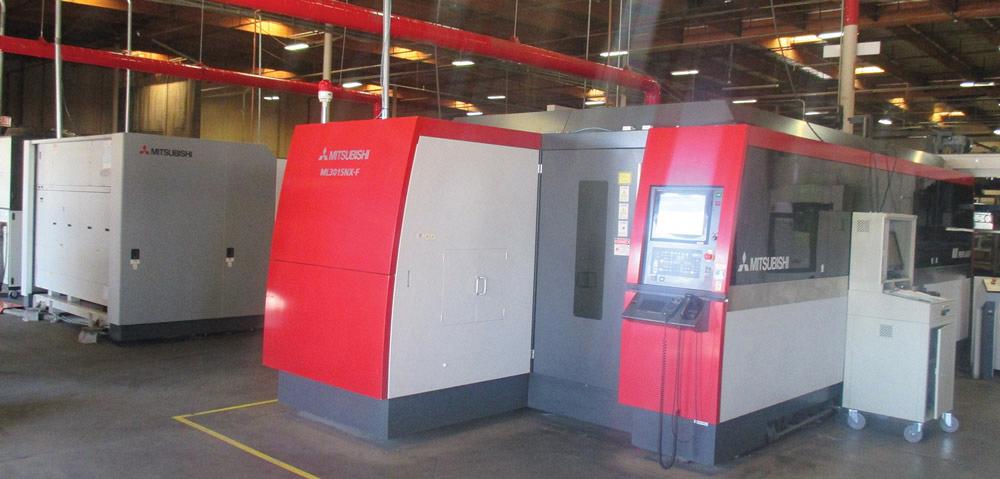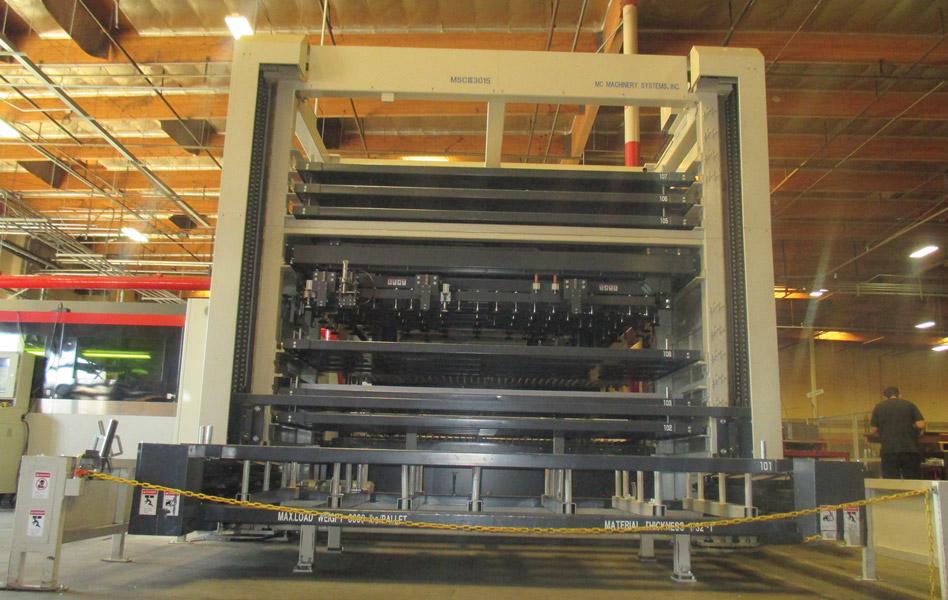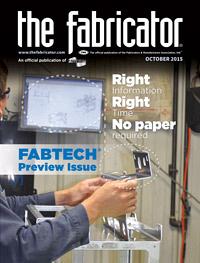Editor-in-Chief
- FMA
- The Fabricator
- FABTECH
- Canadian Metalworking
Categories
- Additive Manufacturing
- Aluminum Welding
- Arc Welding
- Assembly and Joining
- Automation and Robotics
- Bending and Forming
- Consumables
- Cutting and Weld Prep
- Electric Vehicles
- En Español
- Finishing
- Hydroforming
- Laser Cutting
- Laser Welding
- Machining
- Manufacturing Software
- Materials Handling
- Metals/Materials
- Oxyfuel Cutting
- Plasma Cutting
- Power Tools
- Punching and Other Holemaking
- Roll Forming
- Safety
- Sawing
- Shearing
- Shop Management
- Testing and Measuring
- Tube and Pipe Fabrication
- Tube and Pipe Production
- Waterjet Cutting
Industry Directory
Webcasts
Podcasts
FAB 40
Advertise
Subscribe
Account Login
Search
Venturing into fiber laser cutting
Lynam Industries Inc. prepares itself to make sure a big investment pays off
- By Dan Davis
- October 7, 2015
- Article
- Laser Cutting
Troy Lindstrom is perfectly clear on this: He’s interested in gaining new customers for his metal fabrication company, Lynam Industries Inc., but he doesn’t want just any customers.
The Fontana, Calif.-based fabrication shop is not a job shop, where anyone with an idea for a metal contraption might walk through the front door. In fact, his business doesn’t even have a sign indicating to the passerby what type of manufacturing might be happening behind the closed doors.
This is a business that grew serving the data and telecommunication companies of Southern California in the 1990s. They needed quality fabrications delivered in a timely manner and rewarded suppliers that were cost-effective and reliable.
Lynam Industries branched out after the economic downturn of 2001, looking to diversify its customer base. Those efforts have been rewarded with key accounts in the security sector, such as enclosures for X-ray inspection devices, and in fitness equipment.
Lynam Industries is an extension of its OEM clients’ business. The metal fabricator is responsive to the OEMs’ requests and works to keep manufacturing costs down, and the OEM clients share forecasts with Lynam Industries, which helps to solidify production schedules and capital equipment investment plans.
The need for new fabricating technology is actually where Lynam Industries has something in common with job shops. Sometimes it’s the only way to remain competitive in a price-sensitive market.
The Business Model
Lynam Industries can thank its current success to the rise of the Fox television network. Lindstrom’s company was partnered with some woodworkers, and together they produced video and audio editing stations for the network’s affiliates.
“Back then I didn’t know what a data center was,” Lindstrom said.
He learned shortly thereafter, however. That work led the company into more fabrication work centered around racks.
This early work experience also helped to influence the company’s business model for producing parts, which includes coordinating inventory in many instances for its OEM customers, assembling parts, and shipping them to the OEM customers’ end users.

Figure 1
Moving downstream operations to another building allowed Lynam Industries Inc. to locate its CO2 and fiber laser
cutting machines in the same area.
Lindstrom described Lynam Industries’ typical customer as a Fortune 1000 company with products that get sold into a distribution chain. For example, the fabricator might be responsible for eight of an OEM’s products, which share 25 common fabricated components. Lynam Industries chooses to make certain parts for inventory and other parts on an as-needed basis. The OEM doesn’t care as long as the product is shipped as promised to parties in the distribution chain.
Shipping is no simple task, either. The products are assigned a part number, cataloged, and boxed according to specific directions from each OEM client.
“The goal is a high level of service and making sure the customer’s customer, whoever the end user is, never is delayed in getting parts,” Lindstrom said. “Our little tagline is, ‘We can do anything you want by tomorrow; we just can’t do everything you want by tomorrow.’”
The short-term focus for all of these customer relationships is satisfaction, he added. As a result, maximizing margins is not. Lindstrom described that jobs have to be processed efficiently on Lynam Industries’ shop floor or they run the risk of turning unprofitable. The thin margins do not leave a lot of room for estimating mistakes.
That was evident when the fab shop purchased its first CO2 laser cutting machine from Mitsubishi/MC Machinery Systems in 2010. It was needed to cut thicker and hard-to-punch material that the company’s five turret punch presses struggled with.
It also was evident in 2013 when Lindstrom decided that the CO2 laser cutting machine couldn’t keep up with the production rates needed for the amount of sheet metal work that the fab shop was getting.
“The whole industry has changed over the last 20 years—from where it used to be eight weeks and you had a two- to three-month backlog to the point where none of the major corporations give you any backlog orders or blanket orders,” Lindstrom said. “Everything is sort of built to order with 10-day delivery.”
Lynam Industries needed a drastic improvement in laser cutting speed, but it wasn’t going to rush blindly into this capital equipment purchase. The metal fabricator took its time and understood exactly what was going to happen when the new fabricating technology hit its shop floor.
Going the Fiber Laser Way
The company installed its 2.5-kW NX-F fiber laser cutting machine from Mitsubishi/MC Machinery Systems in January 2014 (see Figure 1). It was intended to provide the high cutting speed that the company just couldn’t get from its CO2 laser.
“We needed the speed of the fiber laser to make more products economically,” Lindstrom said. “The CO2 laser could not keep up with demand needed on light-gauge sheet metal, and its economic efficiency was limited to thick metal work. We needed a third choice besides turrets or a CO2 laser, and the fiber laser was the answer.”

Figure 2
This eight-shelf storage tower is enough to keep Lynam Industries’ laser cutting machines busy over extended shifts.
The fiber laser cutting head, which doesn’t contain the mirrors found in a CO2 cutting head, is able to move 4,724 IPM along a single axis, according to the Mitsubishi technical specifications. In materials around 0.40 in. thick, the fiber laser is believed to cut almost three times faster than a slightly more powerful CO2 laser. That cutting speed disparity is reduced when the fiber laser is programmed to cut thicker material. Lindstrom said that as material reaches around 11 gauge, he sees both laser cutting machines demonstrating similar cutting speeds.
But when the fiber laser—so-called because the laser is created by diodes that are fed into fiber-optic cables where the excitation process takes place and then is delivered to the cutting head by another fiber-optic cable similar to one used for data transfer—gets going with cutting thin gauges, it needs to be constantly fed. That’s why Lynam Industries erected a material storage tower with an automated loading and unloading system for both the fiber laser and its older CO2 machine (see Figure 2). The dual-pallet system always has a new sheet ready to be loaded once a cutting job is completed on either machine.
“We followed the keep-it-simple policy, and we bought a relatively simple loader/unloader rather than a more complicated part-sorter style,” Lindstrom said. “You can kill yourself with technology if you go too far.”
To prepare for the fiber laser’s arrival, Lynam Industries rearranged its entire shop. It moved its assembly, packaging, and warehousing activities to a nearby building. That freed up room for the new laser cutting cell.
Today the company has a building dedicated to manufacturing. Trailers run back and forth between the two buildings. Altogether, Lynam Industries has about 150,000 square feet dedicated to shop floor operations.
Making It Work
“You only get one shot at this,” Lindstrom said. “You have to take all of the information that you can gather and try to make a good choice.”
Even though fiber laser cutting is a relatively new fabricating technology, having debuted on the global stage at the 2008 EuroBLECH event in Hanover, Germany, Lindstrom was confident in his choice of cutting technology. He had to be because he simply couldn’t afford to have the machine not cutting parts as efficiently as he thought it would.
He said that the cost of the new equipment is amortized over a 16-hour day. (Lynam Industries’ 150 employees are spread over two shifts.) The laser needs to be cutting as much as possible if the company is to get the expected return on investment and produce in a way that contributes to more profitable jobs.
That’s one of the reasons the metal fabricator said it elected to go with the Mitsubishi fiber laser cutting machine. The CO2 machine had performed admirably for five years over 16-hour days, and he wanted the same reliability from the new laser.
“That’s what I wanted even though other machines claim faster cut speeds,” Lindstrom said. “Your cut speed is zero when the machine isn’t running.”
The fiber laser hasn’t stopped running since its implementation. It is actually pushing downstream activities to operate at a faster pace, according to Lindstrom.
To respond to the need for additional bending capacity, Lynam Industries purchased a panel bender for forming large panels, which are difficult to handle on a press brake, and for hemming, which requires special tooling to do on a press brake. It has 10 press brakes, but probably will add at least one more by the end of the year.
To get the press brakes, as well as other fabricating equipment, up and running as quickly as possible, operators only have to download the job program, prep the machine, and start the job. Manufacturing engineers prepare all job programs and work instructions in the front office, and they are ready even before the job router hits the floor.
Production is now reaching the point where it’s making it easier for the fabricator to keep up in the world of the 10-day turnaround. When everything is clicking, it can get a 3-D drawing from a customer, immediately produce a nesting program for the cutting job, cut a prototype piece, determine if it’s OK or make the appropriate changes, and by the evening shift begin production using its new laser cutting capability. With the fiber laser’s automated lens focusing and material loading/unloading, even a large job can be completed during a skeleton or unmanned shift before the morning crew shows up to work.
Sensible Investments
Lindstrom said he is confident that the investment in the new laser cutting capacity will pay off. The machine is operating as promised, and the company’s preparation has paid off, too, in that there were no major hiccups during installation and early operation. Looking down the road, the company thinks the machine will require less maintenance as it doesn’t have the moving parts or mirrors found in its CO2 equivalent.
The lack of surprises has helped Lynam Industries keep up with work and maintain a solid cash flow position, Lindstrom said. That feeds the ability to invest in new equipment when it’s needed to respond to changing customer demands or market developments.
“It’s part of the plan,” Lindstrom said. “You can’t stay relevant if you don’t have the latest equipment, and you can’t buy the latest equipment if you aren’t growing.”
About the Author

Dan Davis
2135 Point Blvd.
Elgin, IL 60123
815-227-8281
Dan Davis is editor-in-chief of The Fabricator, the industry's most widely circulated metal fabricating magazine, and its sister publications, The Tube & Pipe Journal and The Welder. He has been with the publications since April 2002.
subscribe now

The Fabricator is North America's leading magazine for the metal forming and fabricating industry. The magazine delivers the news, technical articles, and case histories that enable fabricators to do their jobs more efficiently. The Fabricator has served the industry since 1970.
start your free subscription- Stay connected from anywhere

Easily access valuable industry resources now with full access to the digital edition of The Fabricator.

Easily access valuable industry resources now with full access to the digital edition of The Welder.

Easily access valuable industry resources now with full access to the digital edition of The Tube and Pipe Journal.
- Podcasting
- Podcast:
- The Fabricator Podcast
- Published:
- 04/16/2024
- Running Time:
- 63:29
In this episode of The Fabricator Podcast, Caleb Chamberlain, co-founder and CEO of OSH Cut, discusses his company’s...
- Trending Articles
Tips for creating sheet metal tubes with perforations

Supporting the metal fabricating industry through FMA

JM Steel triples capacity for solar energy projects at Pennsylvania facility

Are two heads better than one in fiber laser cutting?

Fabricating favorite childhood memories

- Industry Events
16th Annual Safety Conference
- April 30 - May 1, 2024
- Elgin,
Pipe and Tube Conference
- May 21 - 22, 2024
- Omaha, NE
World-Class Roll Forming Workshop
- June 5 - 6, 2024
- Louisville, KY
Advanced Laser Application Workshop
- June 25 - 27, 2024
- Novi, MI



























